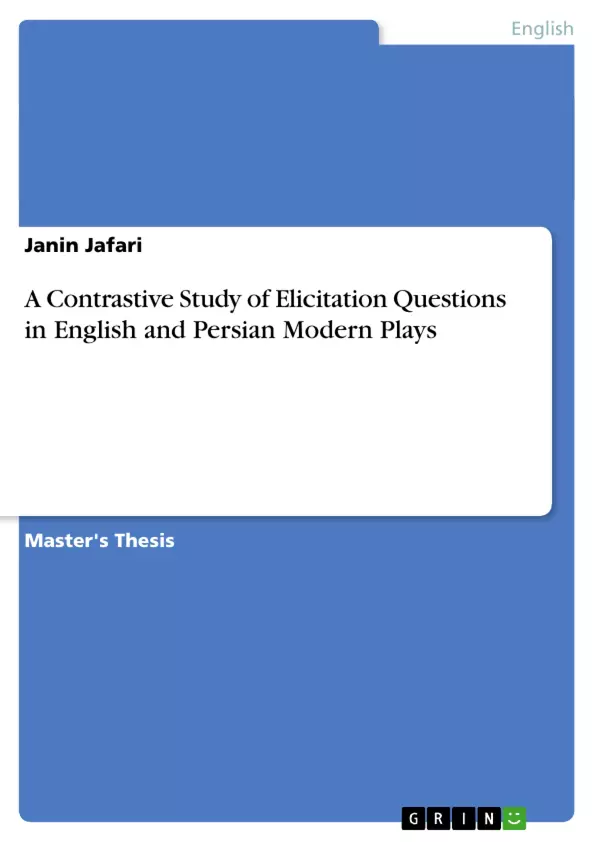ABSTRACT
A Contrastive Study of Elicitation
Questions in English and
Persian Modern Plays
By
Janin Jafari
Questioning is one of the important skills in language learning. Moreover, understanding the discourse function of questions will help learners master the uses of questions. The purpose of the present study was to verify the applicability of Tsui’s (1995) model of conversational analysis, specifically to the different subclasses of ‘Elicitation questions’ (i.e., inform, agree, commit, repeat and clarify) in English and Persian. This study also intended to contrast the subcategories of ‘Elicitation questions’ in English and Persian modern plays. To achieve the objectives, three modern English plays and three modern Persian plays were selected. In order to determine the frequency of each subcategory of ‘Elicitation questions’ of each language 361 instances from the English plays and 337 instances from the Persian plays were analyzed and compared. A Chi-square test was used to determine whether the difference was statistically significant.
The results indicated that Tsui’s characterization of the elicitation regardless of its syntactic form is feasible. Furthermore, Tsui’s classification of ‘Elicitation questions’ into five subcategories in terms of discourse functions of the utterances is applicable. The findings also showed that first, both English and Persian texts used more Elicit: Inform and Elicit: Clarify; second, English and Persian texts used less Elicit:
Commit and Elicit: Repeat respectively; third, Persian texts used Elicit:
Agree twice more than those of English texts. The stated differences were shown to be statistically significant.
Inhaltsverzeichnis (Table of Contents)
- Chapter 1: Introduction
- 1.1: Statement of the Problem
- 1.2: Objectives of the Study
- 1.3: Research Questions
- 1.4: Significance of the Study
- 1.5: Delimitations of the Study
- 1.6: Definitions of Key Terms
- Chapter 2: Review of Related Literature
- 2.1: Conversational Analysis
- 2.2: Elicitation Questions
- 2.3: Discourse Functions of Questions
- 2.4: Previous Studies on Elicitation Questions
- Chapter 3: Methodology
- 3.1: Research Design
- 3.2: Population and Sample
- 3.3: Data Collection
- 3.4: Data Analysis
- Chapter 4: Findings and Discussion
- 4.1: Frequency of Elicitation Questions in English and Persian Plays
- 4.2: Comparison of Elicitation Questions in English and Persian Plays
- 4.3: Discussion of Findings
- Chapter 5: Conclusion and Recommendations
Zielsetzung und Themenschwerpunkte (Objectives and Key Themes)
This study investigates the use of elicitation questions in English and Persian modern plays. The research aims to determine the applicability of Tsui's (1995) model of conversational analysis to these languages and to contrast the subcategories of elicitation questions in English and Persian dramatic texts. The key themes explored in this thesis include:- The discourse function of questions in language learning.
- The applicability of Tsui's model of conversational analysis to English and Persian.
- The frequency and distribution of elicitation question subcategories in both languages.
- A comparative analysis of elicitation questions in English and Persian modern plays.
- The significance of the findings for language teaching and learning.
Zusammenfassung der Kapitel (Chapter Summaries)
Chapter 1: Introduction introduces the research topic, outlines the study's objectives and research questions, and discusses the significance and scope of the study. It also defines key terms relevant to the research. Chapter 2: Review of Related Literature provides a comprehensive overview of existing research on conversational analysis, elicitation questions, and their discourse functions. It also examines previous studies that have explored the use of elicitation questions in different languages. Chapter 3: Methodology outlines the research design, data collection methods, and data analysis procedures used in the study. It details the selection of the corpus, the criteria for identifying and classifying elicitation questions, and the statistical techniques employed for data analysis. Chapter 4: Findings and Discussion presents the results of the data analysis, examining the frequency of different elicitation question subcategories in English and Persian plays. It also compares the findings between the two languages and discusses the implications of the results.
Schlüsselwörter (Keywords)
The research focuses on the discourse function of questions, conversational analysis, elicitation questions, English and Persian modern plays, comparative linguistics, and language teaching. The study employs a quantitative approach to analyze the frequency and distribution of different subcategories of elicitation questions in both languages.- Citar trabajo
- Janin Jafari (Autor), 2013, A Contrastive Study of Elicitation Questions in English and Persian Modern Plays, Múnich, GRIN Verlag, https://www.grin.com/document/233519



